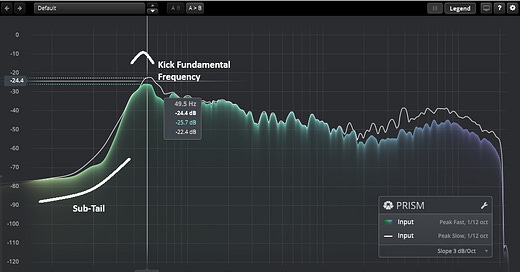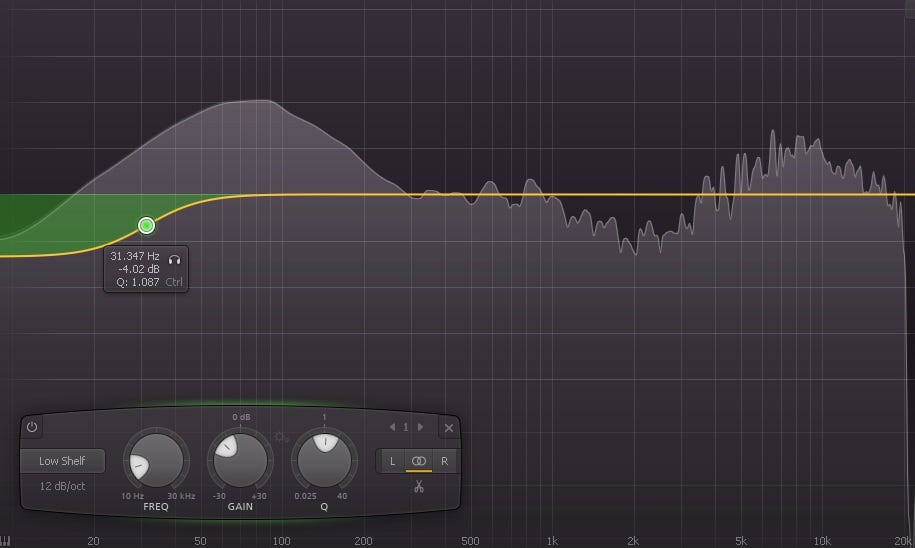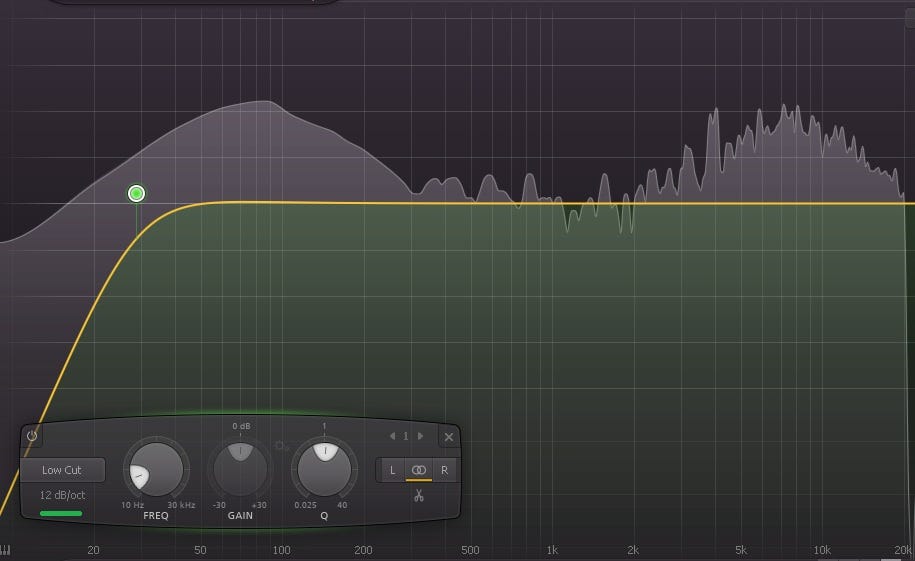Warning: Stop doing these EQ myths on your Kick Drums. 🎵🎶🎵 [056]
Eq Kick Drum & Low-end management - Don't make this mistake
In electronic music, kick samples often have a fundamental frequency between 40 and 50Hz. Of course, this means that when you look at a track through a spectrum analyser, the intensity will decrease towards the lower frequencies.
This doesn't necessarily mean a steep low-cut filter has been applied to the track. The steeper the filter, the greater the potential for phase shifts that can negatively affect transients, resulting in less punch and less clarity of a kick.
However, in a mastering context, I prefer a low-shelf EQ or a gentler high pass filter (6-12 dB/oct) rather than aggressive cuts.
The same goes for music production. I'm not a fan of applying a steep low-cut filter directly to the fundamental kick. I'd rather shape the bass or rumble with an EQ, but of course, taste is subjective.
When it comes to sound design, especially for kick and bass or low-end rumble, there are no strict rules, if it sounds good, it sounds good. But actually I never put a low-cut filter on my main kick drums.
Below, I’ve outlined my approach to producing powerful, clear kicks without sacrificing their natural dynamics in more detail.
40-50 Hz: Why It Defines Your Kick’s Power
The 40-50Hz range is where most kicks generate their physical presence with their fundamental frequency. This frequency band is critical for translating energy on large sound systems while maintaining headroom in your mix.
A spectrum analyzer will reveal this dominance, with a gradual roll-off (Sub-tail) below the fundamental frequency. Importantly, this roll-off is not always indicative of a low-cut filter being used; it often reflects the natural acoustic properties of the sample.
Genre-specific fundamental frequencies of the kick:
Techno/House: Prioritize tight, focused energy at 40-50 Hz.
Trap: You might dip below 40 Hz for a deep low-end.
Trance/Progressive: Kicks Samples might creep up to 50-60 Hz for a warmer feel.
It's important to note that the exact frequency can vary depending on the specific kick sample used and the desired interaction with other elements in the mix, particularly the bassline. For instance, some producers opt for kick drums with fundamentals around 80–100 Hz to create space for a sub-bassline occupying the lower frequencies.
Choose the right Kick sample.
Beyond the fundamentals, I consider sample selection critical. Matching the kick’s length and tone to the track’s genre is key—short decays suit techno, while longer kicks work well in Trap or hip-hop.
Kick vs. Bass: Cohesive Frequency Management
The 40-100 Hz zone is a battleground where kicks and basslines can easily compete, leading to muddiness.
To maintain clarity, I use dynamic ducking by sidechaining the bass to the kick—with a fast attack (10-30 ms) and a moderate release (50-150 ms) to ensure rhythmic cohesion.
I also strive for EQ separation by reserving 40-50 Hz for the kick and letting the bass dominate the frequencies above 50 Hz. For example, in a deep house track, I might high-pass the bass at 45 Hz and boost its midrange (80-120 Hz) to retain warmth without conflict.
EQ Kick Drum? Balancing Precision and Phase Integrity
As I have written before, I hardly ever use a low-cut filter on my main kick.
Avoid applying steep filters directly to the kick’s fundamental frequency. Instead, shape conflicting elements (e.g., basslines or other low-end elements) to maintain the kick’s natural dynamics.
Excessive processing in the sub-frequencies of a Kick risks compromising transient detail and punch. Here’s how to navigate this:
Low-Shelf EQ: My preferred mastering technique for nuanced low-end control without introducing phase shifts.
Gentle High-Pass Filters (6-12 dB/oct): Ideal for attenuating subsonic rumble (20-30 Hz) without distorting the kick’s character.
Steep Filters (24+ dB/oct): Use with caution; these introduce phase shifts that might dull transients, reducing punch and clarity of the Kick.
Tip: I also use reference analysis tools like TDR Prism to A/B my kicks against other commercial tracks, ensuring I choose the right kick sample with a fundamental frequency that balances sub-energy and transient sharpness perfectly.
I hope this breakdown helps you understand my approach to kick and low-end design.
Effective sound design is as much an art as it is a science, and I’m always here to share insights or discuss further if you have any questions.
Best regards,
Marcus







